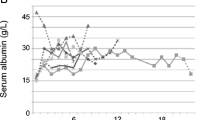Abstract
Maple syrup urine disease results in accumulation of leucine and its metabolites, which may lead in the long term to neurological dysfunction. In acute neonatal crises, large amounts of leucine may be removed by continuous venovenous haemofiltration. This extracorporeal technique has its risks and hazards, which increase with duration of treatment. We report three neonates in life-threatening conditions due to maple syrup urine disease, treated for not more than 12h with various continuous venovenous techniques: continuous haemofiltration, haemodiafiltration and haemodialysis. The efficiency of and tolerance to these techniques was evaluated. For all three patients, plasma leucine levels decreased dramatically from 2186, 3818 and 2536 µmol/L to 1131, 1275 and 488 µmol/L, respectively. Leucine clearance obtained was 4.28 ml/min in haemodiafiltration. Their patients' neurological status improved rapidly and they have a normal developmental quotient at 22 months, 13 months, and 11 months of age, respectively. Tolerance was good except for hypothermia and drop in haematocrit in all cases. Haemodiafiltration management was more cumbersome and time consuming because it required continual adjustment of the substitution fluid flow rate to precisely balance inflow and outflow rates. We recommend continuous venovenous haemodialysis as the therapy of choice. It might be anticipated that improvement of this technique, by increasing dialysate flow rate and blood flow rate, will allow leucine concentration to be decreased below 1000 µmol/L within 6-8 h, whatever the initial level.
Similar content being viewed by others
REFERENCES
Assadi FK (1988) Treatment of acute renal failure in an infant by continuous hemodialysis. Pediatr Nephrol 3: 320–322.
Bunchman T, Maxvold N, Kershaw D, Sedman A, Custer J (1995) Continuous venovenous hemodiafiltration in infants and children. Am J Kidney Dis 25: 17–21.
Casadevall I, Ogier H, Germain JF, et al (1992) Hemofiltration artérioveineuse continue: prise en charge en cas d'une leucinose néonatale. Arch Fr Pediatr 49: 803–805.
Falk M, Knight J, Roy L, et al (1994) Continuous venovenous haemofiltration in the treatment of inborn errors of metabolism. Pediatr Nephrol 8: 330–333.
Gaull GE, Tallan HH, Laijtha A, Rassin DK (1975) Pathogenesis of brain dysfunction in inborn errors of amino acid metabolism. In Gaull GE, ed. Biology of Brain Dysfunction. New York: Plenum Press, 47–143.
Gouyon JB, Desgres J, Mousson C (1994) Removal of branched-chain amino acids by peritoneal dialysis, continuous arteriovenous hemofiltration and continuous arteriovenous hemodialysis in rabbits: implications for maple syrup urine disease treatment. Pediatr Res 35: 357–361.
Jouvet P, Poggi F, Saudubray JM (1995) Continuous venovenous haemofiltration in the acute treatment of inborn errors of metabolism (Letter). Pediatr Nephrol 9: 127.
Kaplan P, Mazur A, Field M, et al (1991) Intellectual outcome in children with maple syrup urine disease. J Pediatr 119: 46–50.
Langenbeck U, Wendel U, Luthe H (1979) Renal clearance of branched chain 2-oxo-acids in maple syrup urine disease. J Clin Chem Clin Biochem 17: 176–177.
Lister G, Moreau G, Moss M, Talner N (1984) Effects of alterations of oxygen transport on the neonate. Semin Perinatol 8: 192–204.
Ogier de Baulny H, Saudubray HM (1995) Emergency treatments. In Fernandes J, Saudubray JM, Van Den Berghe G, eds. Inborn Metabolic Diseases: Diagnosis and Treatment. Berlin: Springer-Verlag, 47–55.
Paret G, Cohen A, Bohn D, et al (1992) Continuous arteriovenous hemofiltration after cardiac operations in infants and children. J Thorac Cardiovasc Surg 104: 1225–1230.
Parini R, Piceni Sereni L, Clerici Bagozzi D, et al (1993) Nasogastric drip feeding as the only treatment of neonatal maple syrup urine disease. Pediatrics 92: 280–283.
Ronco C (1993) Continuous renal replacement therapies for the treatment of acute renal failure in intensive care patients. Clin Nephrol 40: 187–198.
Saudubray JM, Ogier H, Charpentier C, et al (1984) Neonatal management of organic acidurias. Clinical update. J Inher Metab Dis 7(supplement 1): 2–9.
Snyderman S (1988) Treatment outcome of maple syrup urine disease. Acta Paediatr Jpn 30: 417–424.
Thompson G, Butt W, Shann F, et al (1991) Continuous venovenous hemofiltration in the management of acute decompensation in inborn errors of metabolism. J Pediatr 118: 879–884.
Van Ameringen M, Fouron J, Bard H, et al (1981) Oxygenation in anemic newborn lambs with high or low oxygen affinity red cells. Pediatr Res 15: 1500–1503.
Zobel G, Trop M, Ring E, Grubbauer HM (1987) Continuous arteriovenous hemofiltration in critically ill children with acute renal failure. Crit Care Med 15: 699–700.
Author information
Authors and Affiliations
Rights and permissions
About this article
Cite this article
Jouvet, P., Poggi, F., Rabier, D. et al. Continuous venovenous haemodiafiltration in the acute phase of neonatal maple syrup urine disease. J Inherit Metab Dis 20, 463–472 (1997). https://doi.org/10.1023/A:1005314025760
Issue Date:
DOI: https://doi.org/10.1023/A:1005314025760




